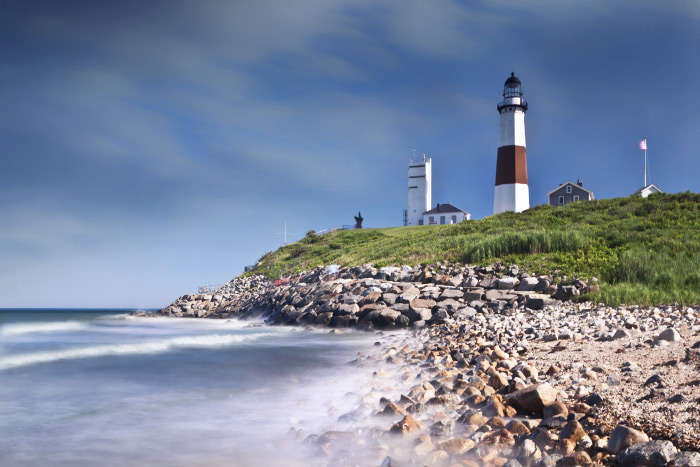Rising Seas: Barriers in Montauk, Wainscott, East Quogue & Sag Harbor

Since the English settlers first came to the Hamptons in 1640, the residents have had their beach rights protected, in common, by a series of laws. The laws, decreed by the Governor of New York on behalf of King Charles I of England, declared that forevermore the residents of each of the East End towns would be entitled to fish, traverse upon, work upon and have access to the entire length of ocean in the community. They would also have the right to access and work in the bays, the harbors and ponds.
The strongest of these laws was the Dongan Patent issued in 1686. Each town would elect “trustees” to enforce these rights. And up until today, the towns of East Hampton, Southampton and Southold have offices for these trustees separate and distinct from the offices of town council members and other town officials to protect these beach, wetland and bay bottom rights of the local residents.
Over the centuries, challenges to the powers of the trustees have been filed, mostly by, in my opinion, selfish individuals with beach houses who want to wall-off the beach to have it for themselves. For the most part, these challenges have been dismissed.
Now, it seems, what lawyers cannot do is being done by the planet itself. Whether you believe that climate change has been caused by careless human behavior, by a temporary atmospheric fluctuation or by God himself, there is now no doubt that the temperatures are going up, the ice caps are melting and the seas are rising. The result is flooding, the loss of beach and the increased assault on oceanfront residences and other institutions. The trustees now are being forced to rethink what needs to be done.
The current question is not who owns the beach but whether there will be a beach in the future with sand dunes to protect the land.
During the last 10 years, the trustees have begun to bend their rules to keep flooding catastrophes from happening. Hard structures—boulders, concrete walls, revetments and jetties—are still against the rules, but more of what used to be considered hard structures are now going by less draconian names and allowed on a “temporary” basis. And all indications are that the seas are going to continue to rise. As a result, temporary might soon be parsed between short-term temporary and long-term temporary, also known as permanent.
As a result of this, I called officials in both East Hampton and Southampton to put together a survey of just what measures have been taken in recent years to hold off the sea for now.
Certainly the largest of the projects is a massive six-mile-long dune-replenishment program extending from Town Line Road separating Wainscott from Sagaponack all the way to Mecox Bay. Along this oceanfront beach, residents with oceanfront homes have banded together to create a $24 million beach protection real estate tax district. Administered by Southampton Town, these wealthy homeowners are paying to have huge amounts of sand dredged from offshore to be placed in front of their homes to protect them. It’s a real case of those wishing to have something paying for it. And it has been quite a success.
The second largest project is the underground oceanfront sandbag seawall that has been constructed for the mile and a half of beach running along the ocean bordering the entire stretch of beachfront in downtown Montauk.
The dunes along this stretch have been carved away for years by the ever-increasing action of the raging ocean surf. Three years ago, during a high tide, the sea broke through the existing dunes and began to flood downtown It would have completely inundated the downtown of Montauk if bulldozers and trucks had not arrived on an emergency basis to plug the holes with huge quantities of sand soon after the breach began. Now, as the next step, an underground sandbag barrier has been placed—a “temporary” structure—and, covered by tons of sand and acres of beach grass, it has resulted in the restoration of the dunes the sea has washed away.
Also in Montauk, the pounding of the sea some years ago stripped away many of the boulders that protected the cliff face upon which sits the Montauk Lighthouse. A new necklace of boulders was put in and is there now. (Surfers objected but in the end saw the necessity of it.)
At the Culloden Shores beach to the west of the Montauk Jetty, an erosion situation due to the rising sea has caused damage that has endangered numerous private homes there. A new project has been proposed, which, if approved, will have sand dredged from between the two jetties removed and brought the necessary few hundred yards to strengthen the beach in front of Culloden.
In Napeague at Lazy Point on the north shore, a program is getting underway where the State of New York has approved a $10 million fund to buy some of the small fishing shacks along the shore there and tear them down. It’s a voluntary program, and those who choose to do so can use the money to either abandon Lazy Point or buy houses further inland, away from the shoreline, which is so vulnerable to flood.
The beach pavilion used by the Georgica Association along their oceanfront in Wainscott has become vulnerable to rising surf. Last month, the residents of that community got trustee approval to pay to truck over sand from a Sagg Pond dredging operation.
More sand dunes and revetments are going to be needed to save the St. Andrews Dune Church in Southampton. Other applications for dunes, revetments and sandbags have been approved to protect homes all along the ocean, in vulnerable places such as Wainscott, Georgica Beach, Southampton Village and on Dune Road. A plan is currently being discussed to raise up the entire five-mile length of Dune Road two feet between the Ponquogue Bridge and East Quogue. It’s not yet been approved, but as time goes by, there will be more and more urgency to it.
Sag Harbor knows it is going to soon have to deal with the flooding that sometimes overwhelms the parking lot in back of Main Street on the side where the movie theater is.
The trustees soldier on. Ironically, as the waters rise and the lakes, ponds and harbors flood, there will be more and more wetlands that come under their jurisdiction. At the same time, however, they are going to have to continue to deal with the ever-increasing cries for help from homeowners and public officials who need waterfront structures protected in the years to come.
Someone once said the Lord giveth and the Lord taketh away. Well, it’s happening, and sooner than we might have thought.



